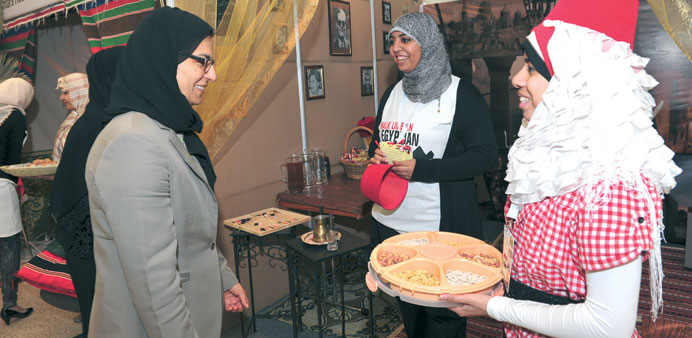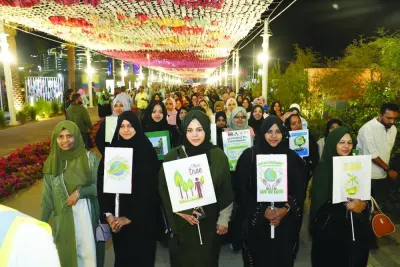Qatar University (QU) students from 24 nationalities have come together to celebrate the institute’s diversity of backgrounds and traditions at the 2013 annual Cultural Village.
The four-day student-run event was opened yesterday by QU president Prof Sheikha Abdulla al-Misnad, who toured the booths at both the men’s and women’s buildings with a delegation that included QU vice-president for Student Affairs Dr Omar al-Ansari, deans and heads of departments, ambassadorial representatives and other guests.
The guests of honour were showered with confetti and streamers as they unveiled the village on the women’s campus.
Under the theme ‘’From the glamour of the past’, students decorated the booths to represent the history, social backgrounds, religions and cultural aspects of their own countries, including Qatar, Iraq, Somalia, Egypt, Bahrain, Algeria, Yemen, Bangladesh, Tunisia, Sudan, Jordan, Pakistan, Syria, Palestine, China, South Korea, Bangladesh, Yemen and India.
Dressed in traditional costumes, they welcomed the guests with songs and dances typical of their countries.
The event is expected to attract an audience from the QU community, schools and institutions, government organisations, embassies and the wider community. Pupils from schools in Doha will be invited to participate, as in previous events.
The QU president said: “Our students have again worked tirelessly to put on an excellent display of culture, heritage and diversity of community, of which Qatar University is proud. The skills they have learned through this experience will stand them in great stead later in their lives.”
Al-Ansari added: “This is a highly popular and inspirational event for the students, QU and the wider community. It is an opportunity not only for the students but for all of us to celebrate each other’s culture and share the spirit of goodwill and tolerance that brings us together. This event is the students’ way of showing their pride in their cultures as well as demonstrating their volunteerism, teamwork, organisation skills and inter-personal relations.”
Mauritanian charge d’affaires Mohamed Abdullah Hadrami, who toured the village, later said: “These cultural activities show the diversity of Qatar University. It is important to display the traditions of all the countries represented by the students here. It is extraordinary to see this in a university and an excellent way of showing Qatar’s interest in the culture of its population.”
Showcasing a traditional home, the Qatari booth on the women’s campus had artefacts from bygone eras - from a rudimentary form of air-conditioning to authentic wedding accessories and even a falcon.
Third-year mass communications student Salwa al-Qahtani said, “We have learned so much from taking part in the cultural village. It has been fascinating to find out about our past and how our parents and grandparents lived, so that we can pass this on to our children and grandchildren. Our lives are so different in many ways now. Our parents would have had a hard life with no air-conditioning ... we need to appreciate how they lived to understand more about our own culture.”
Second-year biology student Sandra C Das represented India. “This has given me a great opportunity to meet students from a variety of backgrounds and to find similarities in our cultures. I even found Arabs who can speak Hindi, which was a great surprise and delight to me,” she said.
The Bahraini booth on the men’s campus depicted the landscape of their state, with the bow of a model dhow and representations of sand dunes. Second-year civil engineering student Mohamed Hassan said, “It’s been a great experience, working successfully as a team with 30 Bahraini students to put our booth together.”
Welcoming the delegation with a traditional song, the Syrian booth represented the Syrian opposition. Second-year mass communications student Yasser Abdullah said: “It has felt great working together for this exhibition. It has been hard work, but rewarding to be standing here now explaining our culture and heritage.”

Prof Sheikha Abdulla al-Misnad visiting one of the booths.


